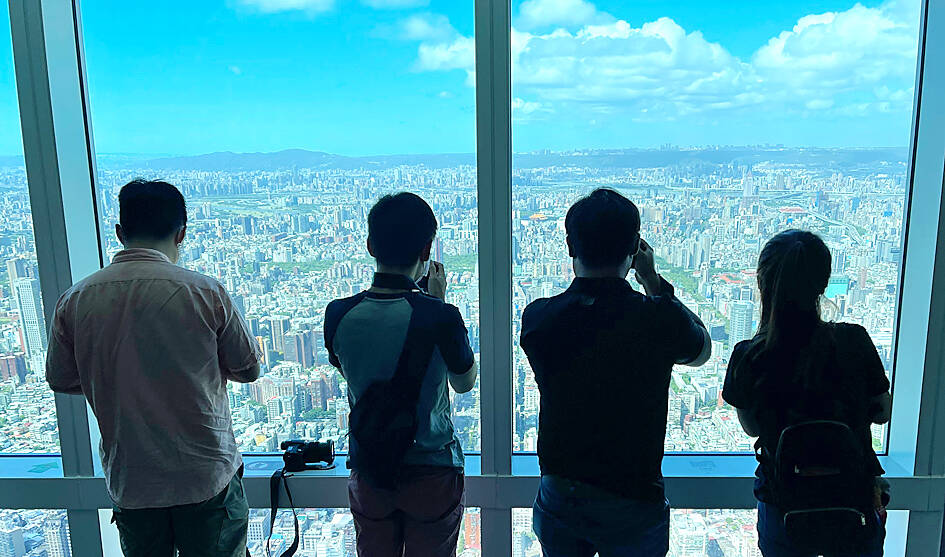Foreign tourist arrivals have risen 40 percent since Taiwan removed border controls in October last year, led by travelers from South Korea, Japan and Southeast Asia, travel e-commerce platform KKday said yesterday.
South Koreans topped the ranking of inbound tourists, followed by travelers from Japan, Hong Kong, Macau, Singapore and Malaysia, KKday said.
The findings were in line with Taiwan’s bid to attract 6 million foreign tourists this year and return to pre-COVID-19-pandemic levels next year.

Photo: CNA
As of Sunday, 1.85 million tourists had arrived in Taiwan this year, the Ministry of Transportation and Communications told a legislative hearing yesterday.
That number might reach 2 million by the end of this month after Taiwan downgraded COVID-19 and made travel into the country easier, it added.
The ministry has offered NT$5,000 worth of travel subsidies for 500,000 free independent tours and 90,000 group tours to attract foreign visitors, it said.
It was closely monitoring the target and would introduce more stimulus measures, if necessary.
The bulk of foreign tourists, 70 percent, visited Taipei and New Taipei City, followed by Taichung, Kaohsiung and Tainan, KKday said.
The destination survey showed that the Taipei 101 Observatory and the National Palace Museum were the top two tourist attractions, followed by New Taipei City’s Jioufen Township (九份), Hualien County’s Taroko Gorge (太魯閣) and the Alishan National Forest Recreation Area (阿里山國家森林遊樂區) in Chiayi County, it said.
Nantou County’s mountainous areas and beaches in Pingtung County’s Kenting National Park (墾丁國家公園) also ranked high.
Inbound tourists’ travel focus differs based on nationality, with South Koreans seeking out Taiwanese cuisine, while Japanese travelers consider Jioufen a must-visit destination, KKday said.
Tourists from Hong Kong and Macau like to travel as much as possible during their visits, but those from Singapore top the list for spending, it said.
Transportation is among the most in-demand services among foreign tourists, as they need high-speed rail tickets, car rentals and one-day or multiday tours to reach New Taipei City’s coastal areas, Nantou County’s Cingjing Farm (清境農場), Taroko Gorge or Alishan, KKday said.
Unique experiences, hot springs, lighting sky lanterns and do-it-yourself bakery activities also rank high on the itinerary of foreign tourists, it said.

Intel Corp chief executive officer Lip-Bu Tan (陳立武) is expected to meet with Taiwanese suppliers next month in conjunction with the opening of the Computex Taipei trade show, supply chain sources said on Monday. The visit, the first for Tan to Taiwan since assuming his new post last month, would be aimed at enhancing Intel’s ties with suppliers in Taiwan as he attempts to help turn around the struggling US chipmaker, the sources said. Tan is to hold a banquet to celebrate Intel’s 40-year presence in Taiwan before Computex opens on May 20 and invite dozens of Taiwanese suppliers to exchange views

Application-specific integrated circuit designer Faraday Technology Corp (智原) yesterday said that although revenue this quarter would decline 30 percent from last quarter, it retained its full-year forecast of revenue growth of 100 percent. The company attributed the quarterly drop to a slowdown in customers’ production of chips using Faraday’s advanced packaging technology. The company is still confident about its revenue growth this year, given its strong “design-win” — or the projects it won to help customers design their chips, Faraday president Steve Wang (王國雍) told an online earnings conference. “The design-win this year is better than we expected. We believe we will win

Chizuko Kimura has become the first female sushi chef in the world to win a Michelin star, fulfilling a promise she made to her dying husband to continue his legacy. The 54-year-old Japanese chef regained the Michelin star her late husband, Shunei Kimura, won three years ago for their Sushi Shunei restaurant in Paris. For Shunei Kimura, the star was a dream come true. However, the joy was short-lived. He died from cancer just three months later in June 2022. He was 65. The following year, the restaurant in the heart of Montmartre lost its star rating. Chizuko Kimura insisted that the new star is still down

While China’s leaders use their economic and political might to fight US President Donald Trump’s trade war “to the end,” its army of social media soldiers are embarking on a more humorous campaign online. Trump’s tariff blitz has seen Washington and Beijing impose eye-watering duties on imports from the other, fanning a standoff between the economic superpowers that has sparked global recession fears and sent markets into a tailspin. Trump says his policy is a response to years of being “ripped off” by other countries and aims to bring manufacturing to the US, forcing companies to employ US workers. However, China’s online warriors